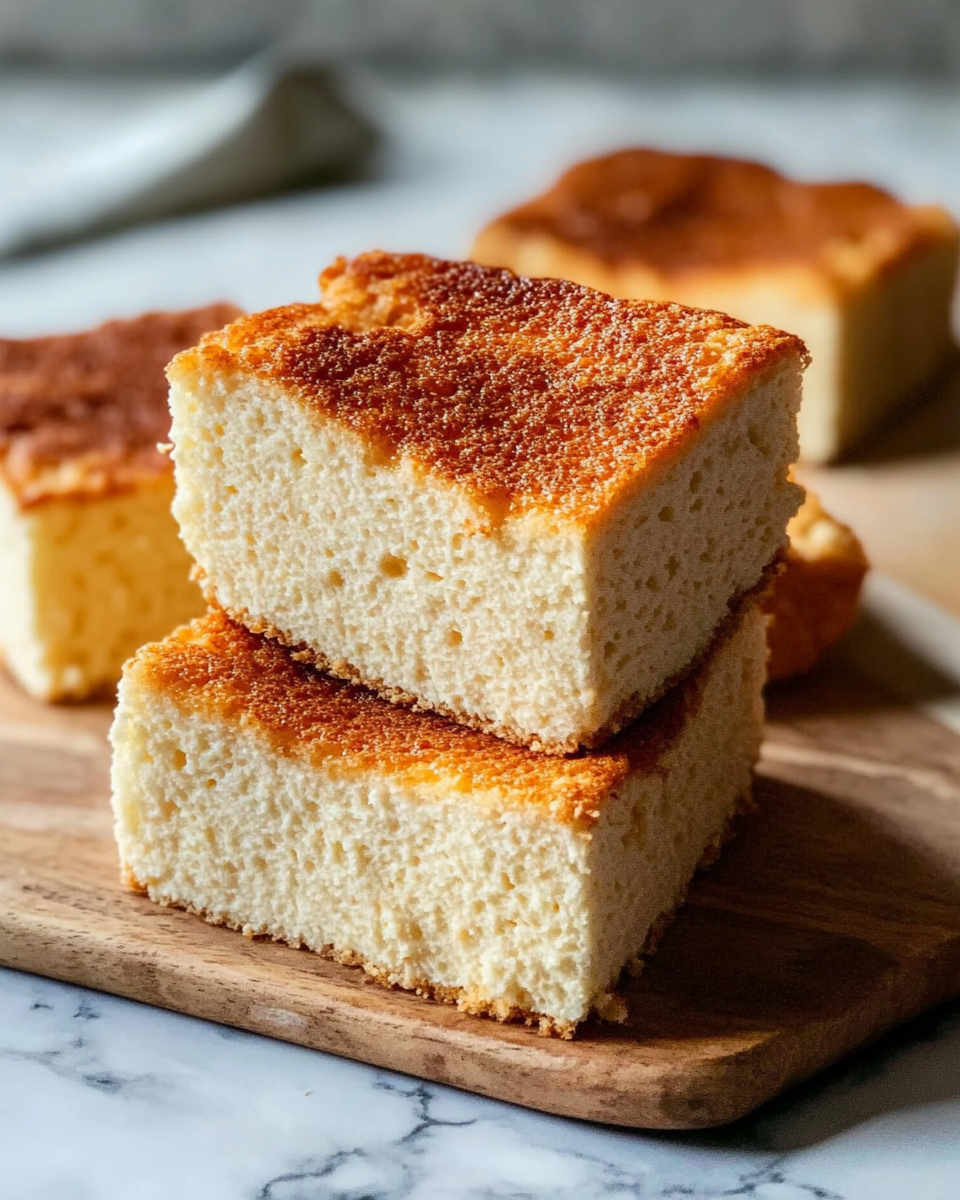This Sugar Free Yogurt Cake is a light, low-calorie, and high-protein dessert that you can enjoy guilt-free every day. Made with simple ingredients like non-fat Greek yogurt, eggs, monkfruit sweetener, and cornstarch, it’s crunchy on top and fluffy inside. The recipe uses a water bath baking method to prevent the cake from collapsing and delivers a moist, cloud-like texture.
Full Recipe:
Ingredients
-
4 large eggs, separated
-
1 ½ cups (350 g/12.5 oz) non-fat Greek yogurt
-
⅓ cup monkfruit sweetener (70 g/2.5 oz)
-
⅓ cup cornstarch (40 g/1.4 oz)
-
1 teaspoon vanilla extract (optional)
Directions
-
Separate yolks from egg whites carefully. Beat egg whites until stiff peaks form. Set aside.
-
Beat monkfruit sweetener, egg yolks, and vanilla extract until light and fluffy.
-
Add Greek yogurt and combine.
-
Sift cornstarch into the mixture and mix well.
-
Gently fold in the beaten egg whites.
-
Line a 7×11 inch baking dish with parchment paper and pour the batter in.
-
Place the baking dish in a larger baking tray, then pour boiling water into the larger tray to reach ¼ to ⅓ up the side of the baking dish (water bath).
-
Bake at 330°F (160°C) for 45 minutes. Increase temperature to 350°F (180°C) and bake for an additional 15 minutes.
-
Turn off oven, crack the door, and let the cake cool inside for 1-2 hours to prevent collapse.
Nutrients
-
Calories: 140 kcal
-
Protein: 16 g
-
Fat: (not specified, but likely low due to non-fat yogurt)
-
Carbohydrates: (not specified exactly, but low since it’s sugar-free)
-
Sugar: (very low, since monkfruit sweetener is used)
This cake is high in protein and low in calories, making it a great guilt-free dessert option.
Why This Cake Is So Special
The Sugar Free Yogurt Cake is unique in its composition and baking method. Unlike traditional cakes that rely heavily on sugar, butter, and flour, this recipe replaces sugar with monkfruit sweetener—a natural, zero-calorie sweetener that doesn’t raise blood sugar levels—making it suitable for diabetics and those managing their carbohydrate intake.
Using non-fat Greek yogurt adds a rich, creamy element while significantly boosting the protein content, helping you stay full and nourished even after indulging in dessert. The yogurt also contributes moisture and a slight tang that balances the sweetness perfectly.
The cornstarch acts as a gluten-free alternative to flour, providing structure without adding heaviness. Together, these ingredients create a cake that’s both light and satisfying, making it perfect for anyone wanting to enjoy dessert without compromising their health goals.
The Science of the Water Bath Baking Method
One of the standout techniques in this recipe is baking the cake in a water bath, also known as a bain-marie. This method involves placing the cake pan inside a larger pan filled with boiling water that reaches partway up the sides of the cake pan.
The water bath creates a gentle, moist baking environment by distributing heat evenly around the cake and preventing the edges from cooking too quickly or drying out. This slow, even heat helps prevent the cake from cracking or collapsing as it bakes, which is common in light, delicate cakes with whipped egg whites.
By controlling the temperature and moisture, the water bath produces a cake with a velvety, cloud-like texture—soft and airy, yet with enough structure to hold its shape perfectly.
How to Achieve the Perfect Texture
The key to this cake’s delightful texture lies in the careful preparation of its ingredients, particularly the eggs. Separating the egg yolks and whites allows you to whip the whites into stiff peaks, which then get folded gently into the batter. This process incorporates air, creating a fluffy, soufflé-like structure.
The yolks, beaten with monkfruit sweetener and vanilla, add richness and sweetness, while the Greek yogurt adds moisture and protein. Sifting in cornstarch ensures the cake’s crumb remains fine and delicate.
Gently folding in the beaten egg whites rather than stirring vigorously preserves the air bubbles, which is crucial to maintaining the cake’s lift and lightness.
After baking, allowing the cake to cool slowly with the oven door cracked prevents rapid temperature changes that can cause the cake to deflate, ensuring a moist, tender crumb that holds together beautifully.
Flavor Profile and Versatility
This sugar-free yogurt cake has a subtle sweetness with a slight tang from the Greek yogurt, balanced perfectly by the vanilla extract if used. The cake’s mild flavor makes it a versatile base that pairs wonderfully with fresh berries, a dollop of sugar-free whipped cream, or a drizzle of keto-friendly chocolate sauce.
Because it’s not overly sweet, it can be enjoyed plain or enhanced with toppings and accompaniments to suit your taste. Its light texture also makes it an excellent canvas for layering with fruit compotes or low-carb frostings for more elaborate desserts.
Nutritional Benefits
This cake’s standout feature is its high protein content—approximately 16 grams per serving—primarily thanks to the non-fat Greek yogurt and eggs. This makes it an excellent choice for those looking to increase protein intake while limiting calories.
The calorie count is low, at about 140 kcal per serving, which supports weight management goals without sacrificing enjoyment. Carbohydrates and sugars are minimal because of the use of monkfruit sweetener and cornstarch instead of traditional sugars and flours.
Fat content is naturally low due to the use of non-fat yogurt and the absence of butter or oil, making it a lean dessert option. This combination of low calories, low carbs, and high protein makes it suitable for many dietary preferences, including low-carb, keto, diabetic-friendly, and calorie-conscious diets.
Tips for Success
-
Make sure to beat the egg whites until stiff peaks form. This step is crucial for the cake’s airy texture.
-
Fold the egg whites gently into the batter to avoid deflating the mixture.
-
Use parchment paper to line your baking dish to prevent sticking and make removal easier.
-
Prepare the water bath carefully, ensuring the water reaches about ¼ to ⅓ of the way up the baking dish to maintain even baking.
-
Don’t skip the slow cooling process in the oven with the door ajar, as this helps prevent the cake from collapsing.
-
Use fresh, high-quality Greek yogurt for the best flavor and texture.
Serving Suggestions
Enjoy this cake as a light dessert after dinner, a protein-packed breakfast treat, or a snack with afternoon tea or coffee. For a fresh and vibrant touch, serve with sliced strawberries, blueberries, or raspberries. A dollop of sugar-free whipped cream or a spoonful of low-carb fruit jam adds extra flavor without extra sugar.
For a festive touch, sprinkle a little cinnamon or nutmeg on top or add citrus zest to the batter before baking. This cake can also be sliced and layered with cream cheese frosting or yogurt mousse for a more decadent dessert option.
Conclusion
This Sugar Free Yogurt Cake is a remarkable dessert that proves you don’t need sugar or heavy fats to enjoy something sweet, satisfying, and delicious. Its light, fluffy texture, high protein content, and low-calorie profile make it an excellent choice for anyone seeking a healthy indulgence that fits their dietary goals.
By using simple, wholesome ingredients and employing the gentle water bath baking method, this cake delivers a moist, tender crumb with a crunchy top that’s truly irresistible. Whether you’re on a keto, low-carb, or calorie-conscious diet, or just looking for a healthier dessert alternative, this Sugar Free Yogurt Cake is a versatile and nourishing choice that will quickly become a favorite.

